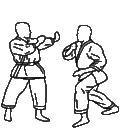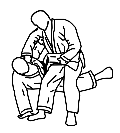Karate throws
Karate's Nage waza (投げ技) is the set of Karate techniques, whereby the opponent is thrown to the ground.[1]
History
Practical experience shows that striking techniques alone could prove ineffective. In some situations or against certain opponents, striking techniques would not work, such as when in a tight space or when engaging in combat with an armored fighter. Over time, Karate sought means to overcome these deficiencies. One way to improve Karate's effectiveness could have stemmed from the fact that when falling or laying down, opponents had fewer means to defend themselves or to retaliate against foes.[2]
Reflecting its core fighting principles, Karate progressively introduced throwing techniques into its repertoire. These techniques were chosen primarily from Japanese and Chinese martial arts such as judo or qinna. The exchanges between martial arts were particularly intense during the 19th and 20th centuries. Judo was perhaps the most influential inspiration behind the new approach. As discussions between Jigoro Kano and Gichin Funakoshi led to throwing techniques being introduced in shotokan, and Kenwa Mabuni, sources for shito-ryu's throwing techniques also included the founder of judo.
Characteristics
Unlike most martial arts, Karate's main concerns about its throwing techniques are the rapidity of execution and applicability at relatively long distances. Judo opponents, on the contrary, are generally less than a meter away from each other. A Karate fighter usually chooses to stay at a safe distance from an opponent. However, all Karate techniques have their equivalent in Judo and ju-jitsu.
Unlike other types of fighting, the throwing techniques of Karate have the primary characteristic of being fast; these can be executed at times from some distance. All have their corresponding moves in Judo and jiu-jitsu. In Karate, the use of tactics to sacrifice, must be accompanied alongside a specific technique to trim, or ukemi waza, ergo to protect the offensive posture.
Kari waza
Kari waza (刈 技 cutting ability) is a set of throwing techniques using hands and/or feet. Unlike what occurs in other martial arts, sweeps in karate do not necessitate holding your adversary's body, although they may help in controlling the technique and the fall of the opponent.[3]
Ashi barai
Deashi barai (足掃) is made in a circular path, scraping the opponent's foot (or leg below the knee) over the opponent's flush and, simultaneously, the waist turns gyaku kaiten. In addition to eventually topple the other, has the usefulness of the unbalance to the making of another attack technique.[4]
Kakato gaeshi
Kakato gaeshi (踵返し) is a stride in the foot: you take behind the heel of one foot, or just pulling or locking with the use of an impulse contrary to the same leg. This can be done as suwari waza (on the knees) or, preferably, in the shiko dashi stance.
Ko soto gari
Ko soto gari (小外刈)is done at close range. The practitioner pulls up the leg of the enemy, from the outside, with the area of a linear motion and teisoku on Jun kaiten belt. This is not to be confused with the technique of barai ashi, where the latter involves trailing or catching the opponent's leg and can be made against the knees to the bottom, ko soto gari while in, and a sweep is made a pulling, so this technique involves the techniques of ko soto gari and ko soto gaki of judo.
Ko uchi gari
Ko uchi gari (小内刈) runs a short distance, pull the opponent's leg, on the inside. It is very similar to the technique ko soto gari.
Nami gaeshi
Nami gaeshi (波返し) is a technique where the leg is passed in a circular motion behind the opponent's leg to the height of the knee joint, while simultaneously pushing the stem in contrary motion while applies atemi target leg. This technique can be used for attack and defence.[5]
The technique nami gaeshi boils down to the leg movement, but is also a defense. The momentum of the upper hand against the opponent is used to increase the effectiveness of the blow. This is not a raster, but it is a versatile technique and is found in the kata Tekki shodan.
O soto gari
O soto gari (大外刈) is performed by scraping or pulling your leg, from the outside, with the opponent's area Kakato conjugated to share outside and back of the leg — fukurahagi —. The movement should be started when you sho zenkutsu at the base, or bottom moroashi without stretching the base, not to lose balance. The final position is identical to the original. And the waist on Jun kaiten turns first and then in reverse. The movement is basically the same kick fumikiri, but runs as a trailing.
O uchi gari
O uchi gari (大内刈) is performed by scraping or pulling the opponent's leg between his legs, similar to o soto gari.
Udewa

Udewa morote gari (腕輪), or Morote gari (諸手刈), is done by holding up both his opponent's legs, locking them both to pull them back. The idea is to harness the recoil motion that will eventually make the opponent or, if not back, it is a direct thrust at the belt line, to knock back.
Kuruma waza
Kuruma waza (车 技) is a set of projections is executed causing the opponent to describe a circular path when it falls, for example they are falling with the circular shape.[6]
Tai otoshi

Tai otoshi (体落し) must be executed with the passage of a leg to block the movement of the opponent's legs while you apply a force on the upper part of your body.
Sutemi waza
Sutemi waza (舍身 技) are the techniques of sacrifice, i.e., they are those movements in which the karateka abdicates his standing posture, tipping adverásrio with its own downfall. As both will fall, who must perform this type of scam should be able to control both his fall on the other, but does so in order not to get hurt, transferring the most energy to the opponent, who will suffer from his fall which is beyond their control.
Judo and jiu-jitsu have both a set of techniques of sacrifice, but with a greater number of movements. In a way, even a karate chop, depending on how it is implemented, can be either judo or even several. For example, tomoe guruma can match both the tomoe-nage on the sumi-gaeshi.
Do not encourage the use of techniques sutemi, because even if you control the movement, there is some degree of unpredictability, and should be used basically as a last option, considering that the solo part (ne waza) of karate is very restricted, because the blows striking methods are effective only in descentendes trajectories.
Kani basami

Kani basami (蟹挟 crab claw) is a move done by passing one leg, lower, or that is closer to the ground behind the opponent's legs with the other but the front row height waist. Optionally, clings with one hand the opponent at shoulder height, to help when the drive to the ground. With a twist of the body, pushing back the leg that lies ahead, drop out.
When done by grasping the shoulder, there are forces throwing the opponent back and down, to give more efficiency to the coup. But if you grab the opponent's shoulder, one must harness the energy of the crash and decide whether to apply a blow with his free hand.
Some commonly known as the stroke of scissors.
References
- ↑ "Nage waza - Throws and Takedown techniques - Martial arts supplies". Retrieved May 10, 2011.
- ↑ MURAT, Richard (2005). Karate: for beginners and advanced. Nova Delhi: Atlantica. pp. 15, 30. ISBN 81-269-0460-7.
- ↑ Структурная схема Сёриндзи Кэмпо [Shorinji Kenpo technical diagram] (PDF) (in Russian). Retrieved May 20, 2011.
- ↑ "Judo and Karate Ashi barai timing". Retrieved 13 March 2011.
- ↑ "KATA TEKKISHODAN" (in Portuguese). Retrieved May 20, 2011.
- ↑ "Dizionario" (in Italian). Retrieved May 20, 2011.